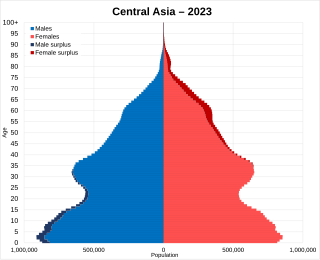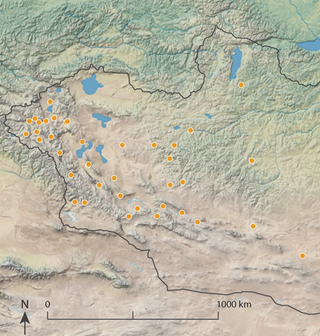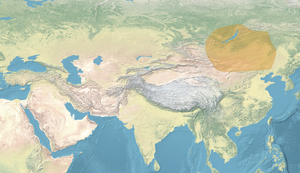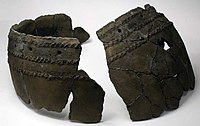The Xiongnu were a tribal confederation of nomadic peoples who, according to ancient Chinese sources, inhabited the eastern Eurasian Steppe from the 3rd century BC to the late 1st century AD. Modu Chanyu, the supreme leader after 209 BC, founded the Xiongnu Empire.
The Afanasievo culture, or Afanasevo culture, is an early archaeological culture of south Siberia, occupying the Minusinsk Basin and the Altai Mountains during the eneolithic era, c. 3300 to 2500 BCE. It is named after a nearby mountain, Gora Afanasieva in what is now Bogradsky District, Khakassia, Russia, first excavated by archaeologist Sergei Teploukhov in 1920-1929. Afanasievo burials have been found as far as Shatar Chuluu in central Mongolia, confirming a further expansion about 1,500 km beyond the Altai mountains. The Afanasievo culture is now considered as an integral part of the Prehistory of Western and Central Mongolia.

The Koban culture or Kuban culture, is a late Bronze Age and Iron Age culture of the northern and central Caucasus. It is preceded by the Colchian culture of the western Caucasus and the Kharachoi culture further east.

Deer stones, sometimes called the Deer stone-khirigsuur complex (DSKC) in reference to neighbouring khirigsuur tombs, are ancient megaliths carved with symbols found mainly in Mongolia and, to a lesser extent, in the adjacent areas in Siberia: 1300 of 1500 the deer stones found so far are located in Mongolia. The name comes from their carved depictions of flying deer. The "Deer stones culture" relates to the lives and technologies of the late Bronze Age peoples associated with the deer stones complexes, as informed by archaeological finds, genetics and the content of deer stones art.
The Tagar culture was a Bronze Age Saka archeological culture which flourished between the 8th and 1st centuries BC in South Siberia. The culture was named after an island in the Yenisei River opposite Minusinsk. The civilization was one of the largest centres of bronze-smelting in ancient Eurasia.

The Prehistory of Siberia is marked by several archaeologically distinct cultures. In the Chalcolithic, the cultures of western and southern Siberia were pastoralists, while the eastern taiga and the tundra were dominated by hunter-gatherers until the Late Middle Ages and even beyond. Substantial changes in society, economics and art indicate the development of nomadism in the Central Asian steppes in the first millennium BC.
The Glazkov culture, Glazkovo culture, or Glazkovskaya culture, was an archaeological culture in the Lake Baikal area during the Early Bronze Age.
Arzhan is a site of early Saka kurgan burials in the Tuva Republic, Russia, some 60 kilometers (40 mi) northwest of Kyzyl. It is on a high plateau traversed by the Uyuk River, a minor tributary of the Yenisei River, in the region of Tuva, 20 km to the southwest of the city of Turan.
Okunev culture, sometimes also Okunevo culture, was a south Siberian archaeological culture of pastoralists of the early Bronze Age dated from the end of the 3rd millennium BC to the early of the 2nd millennium BC in the Minusinsk Basin on the middle and upper Yenisei. It was formed from the local Neolithic Siberian forest cultures, who also show evidence of admixture from Western Steppe Herders and pre-existing Ancient North Eurasians.

The Mongolic peoples are a collection of East Asian-originated ethnic groups in East, North, South Asia and Eastern Europe, who speak Mongolic languages. Their ancestors are referred to as Proto-Mongols. The largest contemporary Mongolic ethnic group is the Mongols. Mongolic-speaking people, although distributed in a wide geographical area, show a high genetic affinity to each other, and display continuity with ancient Northeast Asians.

The nations which make up Central Asia are five of the former Soviet republics: Kazakhstan, Kyrgyzstan, Turkmenistan, Tajikistan and Uzbekistan, which have a total population of about 76 million. Afghanistan is not always considered part of the region, but when it is, Central Asia has a total population of about 122 million (2016); Mongolia and Xinjiang is also sometimes considered part of Central Asia due to its Central Asian cultural ties and traditions, although geographically it is East Asian. Most central Asians belong to religions which were introduced to the area within the last 1,500 years, such as Sunni Islam, Shia Islam, Ismaili Islam, Tengriism and Syriac Christianity. Buddhism, however, was introduced to Central Asia over 2,200 years ago, and Zoroastrianism, over 2,500 years ago.
The climate of Central Asia became dry after the large tectonic collision between the Indian Plate and the Eurasian Plate. This impact threw up the massive chain of mountains known as the Himalayas. The Himalayas, Greater Khingan and Lesser Khingan mountains act like a high wall, blocking the warm and wet climate from penetrating into Central Asia. Many of the mountains of Mongolia were formed during the Late Neogene and Early Quaternary periods. The Mongolian climate was more humid hundreds of thousands of years ago.
The Chandman culture, also known as Chandmani culture, was a nomadic culture that existed in northwestern Mongolia and southern Siberia during the Iron Age, and is also known as the "Sagly-Bazhy culture" on the Russian side of the frontier. It is associated with the Eastern Scythian/Saka horizon, and is part of the more general Saka Uyuk culture.

The Uyuk culture refers to the Saka culture of the Turan-Uyuk depression around the Uyuk river, in modern-day Tuva Republic.

The Sagly-Bazhy culture or Sagly/Uyuk culture, also known as Chandman culture in Mongolia, refers to the Saka culture of the Sayan mountains, in modern-day Tuva Republic. It is the last stage of the Uyuk culture.

The Chemurchek culture, also called Khemtseg, Hemtseg, Qiemu’erqieke, Shamirshak, is a Bronze Age archaeological culture of western Mongolia and the borders of neighbouring countries, such as the Dzungarian Basin of Xinjiang and eastern Kazakhstan. It immediately follows the Afanasievo culture, and is contemporary with the early Tarim Mummies to the south and the Okunev culture to the north. The Chemurchek burials are characterized by large rectangular stone fences, built around collective tombs. The mortuary position of the deceased is similar to that of the Afanasievo culture, but the Chemurchek culture is considered as distinct. The name "Chemurchek culture" is derived from the Chemurchek cemetery in Altay City of Chinese Xinjiang. Chemurchek sites have been identified from western Mongolia to areas as far west as the Ili valley.

The Ulaanzuukh culture, also Ulaanzuukh-Tevsh culture, is an archaeological culture of the Late Bronze Age eastern Mongolia. It likely preceded and was the origin of the Slab-grave culture.

In archaeogenetics, the term Ancient Northeast Asian (ANA), also known as Amur ancestry, is the name given to an ancestral component that represents the lineage of the hunter-gatherer people of the 7th-4th millennia before present, in far-eastern Siberia, Mongolia and the Baikal regions. They are inferred to have diverged from Ancient East Asians about 24kya ago, and are represented by several ancient human specimens found in archaeological excavations east of the Altai Mountains. They are a sub-group of the Ancient Northern East Asians (ANEA).

The Sagsai culture is an early Bronze Age culture of Western Mongolia. It was centered on the Sagsai area and succeeded the Chemurchek culture.

The Munkhkhairkhan culture, also Munkh-Khairkhan or Mönkhkhairkhan was an Middle Bronze Age culture of southern Siberia and western Mongolia, named after Mönkhkhairkhan Mountain in western Mongolia, and dating to 1800–1600 BCE. It immediately follows the Afanasievo culture and the Khemtseg culture. It was contemporary with the Andronovo culture, but its very existence suggests that the Androvo culture did not extend far into Mongolia.






















